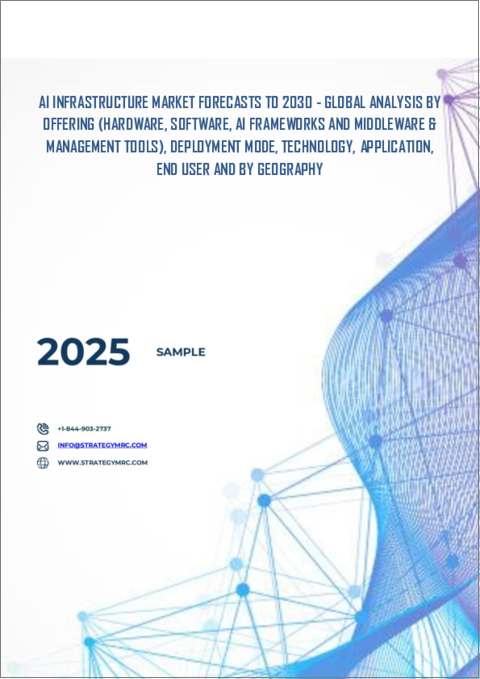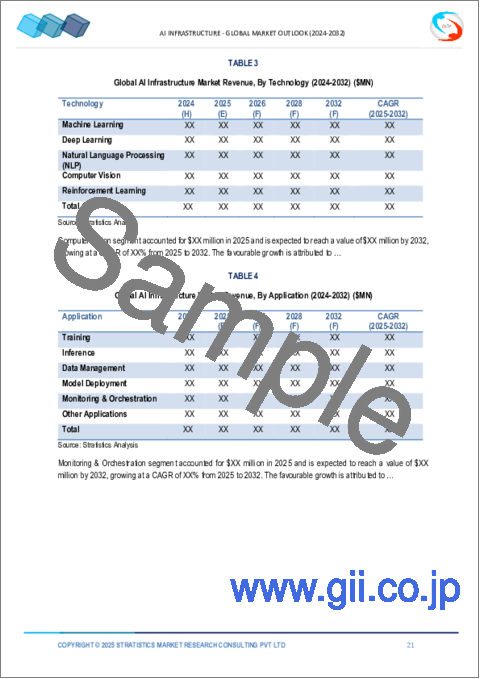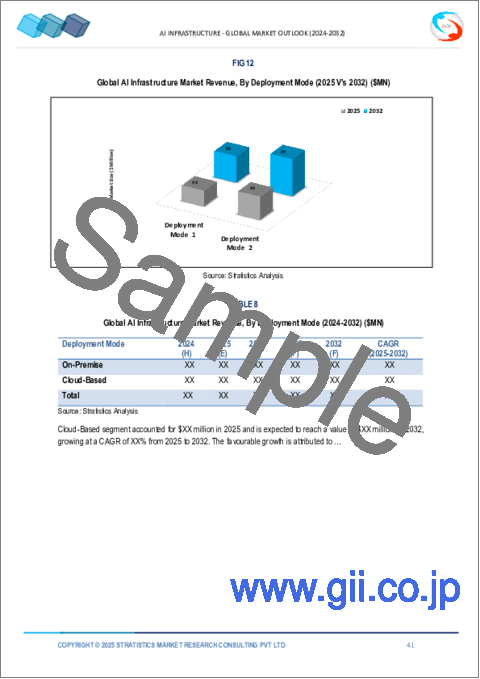|
|
市場調査レポート
商品コード
1725195
AIインフラ市場の2030年までの予測: 提供別、展開モード別、技術別、アプリケーション別、エンドユーザー別、地域別の世界分析AI Infrastructure Market Forecasts to 2030 - Global Analysis By Offering (Hardware, Software, AI Frameworks and Middleware & Management Tools), Deployment Mode, Technology, Application, End User and By Geography |
||||||
カスタマイズ可能
|
|||||||
| AIインフラ市場の2030年までの予測: 提供別、展開モード別、技術別、アプリケーション別、エンドユーザー別、地域別の世界分析 |
|
出版日: 2025年05月03日
発行: Stratistics Market Research Consulting
ページ情報: 英文 200+ Pages
納期: 2~3営業日
|
全表示
- 概要
- 図表
- 目次
Stratistics MRCによると、世界のAIインフラ市場は2025年に402億米ドルを占め、予測期間中のCAGRは30.8%で成長し、2032年には2,633億米ドルに達すると予測されています。
AIインフラには、人工知能アプリケーションの開発、展開、拡張に必要なハードウェアとソフトウェアシステムが含まれます。これには、大規模なデータセットを処理するための強力なGPU、TPU、ハイパフォーマンスコンピューティングクラスタが含まれ、クラウドプラットフォームや、モデルのトレーニングと展開のためのTensorFlowやPyTorchのようなフレームワークも含まれます。また、データストレージ、ネットワーキング、管理ツールをサポートし、効率的で安全かつスケーラブルなAI運用を実現することで、農業、ヘルスケア、金融などの業界がイノベーションと意思決定のためにAIを活用できるようにします。
Cloudsceneの最新データによると、米国には2,701、ドイツには487、英国には456、中国には443のデータセンターがあり、AIインフラ拡大のための強固な基盤を構築しています。
AIチップの進化
GPUやTPUといったAI専用チップの進化により、処理能力が大幅に向上しています。これらのチップはより高速なデータ処理を可能にし、業界全体のリアルタイムAIアプリケーションを促進します。チップメーカーは、AIワークロードを最適化するエネルギー効率の高い高性能設計で、ますます革新を進めています。強化されたチップアーキテクチャは、ディープラーニングモデルを強化し、最小限のレイテンシで複雑なアルゴリズムを実行できるようにしています。AIチップセットの継続的なアップグレードは、AIインフラのスケーラビリティを実現する主要な手段です。
データプライバシーとセキュリティへの懸念
AIシステム内で膨大な量の機密データを扱うことは、重大なプライバシー問題を引き起こします。不十分なセキュリティプロトコルは、インフラをデータ漏洩や悪用にさらす可能性があります。GDPRやCCPAといった世界なデータ規制の遵守は、企業にとって依然として課題です。こうした懸念は、特にヘルスケアや金融などの分野において、AI技術の採用を制限する可能性があります。企業は、ユーザーの信頼と規制遵守を確保するために、安全なフレームワークに多額の投資を行わなければならないです。
ジェネレーティブAIと大規模言語モデルの急増
GPTやDALL-Eのような生成的AIモデルの人気の高まりは、強力なバックエンドインフラストラクチャへの需要を促進しています。開発企業は、モデル開発をサポートする大規模なトレーニング環境への投資を増やしています。モデルの推論とチューニングを大規模に管理するための高スループットコンピューティングに対するニーズが高まっています。この動向は、AIに最適化されたサーバー、ストレージ、ネットワークコンポーネントを提供するベンダーにビジネスチャンスをもたらします。AIインフラストラクチャプロバイダーは、複雑なコンテンツ生成と自動化を必要とする新たな業界に参入できます。
分散型AIシステムにおけるサイバーセキュリティの脆弱性
分散型のAIフレームワークは、データの流れやエンドポイントが分散しているため、悪意のある攻撃にさらされやすいです。エッジデバイスの暗号化やアクセス制御の仕組みが不十分だと、サイバー脅威の影響を受けやすくなります。敵対的な攻撃はAIモデルを操作し、その出力と意思決定を損なう可能性があります。AIネットワークの大規模化により、リアルタイムの脅威監視がますます複雑になっています。永続的なセキュリティの抜け穴は、AIの導入とシステムの完全性に対する信頼を妨げる可能性があります。
COVID-19の影響:
パンデミックは当初、ハードウェアのサプライチェーンを混乱させ、各分野におけるAIインフラの展開を遅らせた。しかし、この危機はデジタルトランスフォーメーションを加速させ、AI対応業務への投資に拍車をかけた。リモートワークやバーチャルサービスにより、クラウドベースのAIインフラへの需要が高まりました。COVID-19はまた、ヘルスケア診断やコンタクトトレーシングのためのAIアプリケーションの進歩を誘発し、インフラストラクチャーのニーズを浮き彫りにしました。
予測期間中、機械学習セグメントが最大となる見込み
機械学習セグメントは、金融、小売、ヘルスケアなどの業界全体に広く適用できるため、予測期間中に最大の市場シェアを占めると予想されます。教師あり・教師なし学習技術の採用が増加しており、MLの使用事例が拡大しています。ML-as-a-Service(MLaaS)を提供するクラウドプラットフォームは、組織の展開を簡素化しています。企業はパターン認識、推薦システム、自動化にMLを活用しています。MLモデルのスケーラビリティと費用対効果により、このセグメントが優位を占めています。
予測期間中、推論セグメントのCAGRが最も高くなる見込み
予測期間中、推論セグメントが最も高い成長率を示すと予測されます。推論エンジンは、学習済みモデルを低レイテンシで実世界のシナリオに展開するために不可欠になっています。エッジシステムや組込みシステムでは、高速でエネルギー効率に優れた推論が求められており、これが成長の原動力となっています。ハードウェアアクセラレータの技術的進歩が、このセグメントの能力を高めています。家電製品や自律走行車におけるAI搭載アプリケーションの普及がこの動向を後押ししています。多様な環境で最適化された推論への需要が、高成長を促進すると予想されます。
最大のシェアを持つ地域
予測期間中、アジア太平洋地域は、スマートシティ構想やデジタル変革への大規模な投資により、最大の市場シェアを占めると予想されます。中国、日本、韓国などの国々は、公共部門と民間部門にAI技術を積極的に展開しています。政府主導のイノベーションプログラムや資金提供がAIインフラ開発を後押ししています。主要な半導体製造拠点が存在することも、この地域の成長をさらに後押ししています。さらに、企業向けクラウドの急速な導入が市場情勢を高めています。
CAGRが最も高い地域:
予測期間中、北米地域は先進的なAI技術の早期導入により、最も高いCAGRを示すと予測されます。大手ハイテク企業やAI研究機関の存在がイノベーションを促進しています。AIインフラコンポーネントへの高い研究開発投資が市場浸透を加速しています。重要産業におけるAI統合を支援する規制枠組みも成長に寄与しています。企業全体でAI主導の自動化への注目が高まっていることが、市場の拡大をさらに加速させています。
無料のカスタマイズ提供:
本レポートをご購読のお客様には、以下の無料カスタマイズオプションのいずれかをご利用いただけます:
- 企業プロファイル
- 追加市場企業の包括的プロファイリング(3社まで)
- 主要企業のSWOT分析(3社まで)
- 地域セグメンテーション
- 顧客の関心に応じた主要国の市場推計・予測・CAGR(注:フィージビリティチェックによる)
- 競合ベンチマーキング
- 製品ポートフォリオ、地理的プレゼンス、戦略的提携に基づく主要企業のベンチマーキング
目次
第1章 エグゼクティブサマリー
第2章 序文
- 概要
- ステークホルダー
- 調査範囲
- 調査手法
- データマイニング
- データ分析
- データ検証
- 調査アプローチ
- 調査資料
- 1次調査資料
- 2次調査情報源
- 前提条件
第3章 市場動向分析
- 促進要因
- 抑制要因
- 機会
- 脅威
- 技術分析
- 用途分析
- エンドユーザー分析
- 新興市場
- COVID-19の影響
第4章 ポーターのファイブフォース分析
- 供給企業の交渉力
- 買い手の交渉力
- 代替品の脅威
- 新規参入業者の脅威
- 競争企業間の敵対関係
第5章 世界のAIインフラ市場:提供別
- ハードウェア
- CPU、GPU、ASIC、FPGA
- ストレージシステム
- ネットワークコンポーネント
- ソフトウェア
- AIフレームワーク
- ミドルウェアと管理ツール
第6章 世界のAIインフラ市場:展開モード別
- オンプレミス
- クラウドベース
第7章 世界のAIインフラ市場:技術別
- 機械学習
- ディープラーニング
- 自然言語処理(NLP)
- コンピュータービジョン
- 強化学習
第8章 世界のAIインフラ市場:アプリケーション別
- トレーニング
- 推論
- データ管理
- モデルの展開
- 監視とオーケストレーション
- その他のアプリケーション
第9章 世界のAIインフラ市場:エンドユーザー別
- ヘルスケアとライフサイエンス
- BFSI(銀行、金融サービス、保険)
- 小売・Eコマース
- 自動車
- 通信
- 政府と防衛
- その他のエンドユーザー
第10章 世界のAIインフラ市場:地域別
- 北米
- 米国
- カナダ
- メキシコ
- 欧州
- ドイツ
- 英国
- イタリア
- フランス
- スペイン
- その他欧州
- アジア太平洋
- 日本
- 中国
- インド
- オーストラリア
- ニュージーランド
- 韓国
- その他アジア太平洋地域
- 南米
- アルゼンチン
- ブラジル
- チリ
- その他南米
- 中東・アフリカ
- サウジアラビア
- アラブ首長国連邦
- カタール
- 南アフリカ
- その他中東とアフリカ
第11章 主な発展
- 契約、パートナーシップ、コラボレーション、ジョイントベンチャー
- 買収と合併
- 新製品発売
- 事業拡大
- その他の主要戦略
第12章 企業プロファイリング
- Advanced Micro Devices, Inc
- Amazon Web Service
- Cadence Design Systems
- Cisco
- Dell
- Graphcore
- Gyrfalcon Technology
- Hewlett Packard Enterprise Development LP
- IBM
- Imagination Technologies
- INTEL
- Micron Technology
- Microsoft
- NVIDIA
List of Tables
- Table 1 Global AI Infrastructure Market Outlook, By Region (2024-2032) ($MN)
- Table 2 Global AI Infrastructure Market Outlook, By Offering (2024-2032) ($MN)
- Table 3 Global AI Infrastructure Market Outlook, By Hardware (2024-2032) ($MN)
- Table 4 Global AI Infrastructure Market Outlook, By CPUs, GPUs, ASICs, FPGAs (2024-2032) ($MN)
- Table 5 Global AI Infrastructure Market Outlook, By Storage Systems (2024-2032) ($MN)
- Table 6 Global AI Infrastructure Market Outlook, By Networking Components (2024-2032) ($MN)
- Table 7 Global AI Infrastructure Market Outlook, By Software (2024-2032) ($MN)
- Table 8 Global AI Infrastructure Market Outlook, By AI Frameworks (2024-2032) ($MN)
- Table 9 Global AI Infrastructure Market Outlook, By Middleware & Management Tools (2024-2032) ($MN)
- Table 10 Global AI Infrastructure Market Outlook, By Deployment Mode (2024-2032) ($MN)
- Table 11 Global AI Infrastructure Market Outlook, By On-Premise (2024-2032) ($MN)
- Table 12 Global AI Infrastructure Market Outlook, By Cloud-Based (2024-2032) ($MN)
- Table 13 Global AI Infrastructure Market Outlook, By Technology (2024-2032) ($MN)
- Table 14 Global AI Infrastructure Market Outlook, By Machine Learning (2024-2032) ($MN)
- Table 15 Global AI Infrastructure Market Outlook, By Deep Learning (2024-2032) ($MN)
- Table 16 Global AI Infrastructure Market Outlook, By Natural Language Processing (NLP) (2024-2032) ($MN)
- Table 17 Global AI Infrastructure Market Outlook, By Computer Vision (2024-2032) ($MN)
- Table 18 Global AI Infrastructure Market Outlook, By Reinforcement Learning (2024-2032) ($MN)
- Table 19 Global AI Infrastructure Market Outlook, By Application (2024-2032) ($MN)
- Table 20 Global AI Infrastructure Market Outlook, By Training (2024-2032) ($MN)
- Table 21 Global AI Infrastructure Market Outlook, By Inference (2024-2032) ($MN)
- Table 22 Global AI Infrastructure Market Outlook, By Data Management (2024-2032) ($MN)
- Table 23 Global AI Infrastructure Market Outlook, By Model Deployment (2024-2032) ($MN)
- Table 24 Global AI Infrastructure Market Outlook, By Monitoring & Orchestration (2024-2032) ($MN)
- Table 25 Global AI Infrastructure Market Outlook, By Other Applications (2024-2032) ($MN)
- Table 26 Global AI Infrastructure Market Outlook, By End User (2024-2032) ($MN)
- Table 27 Global AI Infrastructure Market Outlook, By Healthcare & Life Sciences (2024-2032) ($MN)
- Table 28 Global AI Infrastructure Market Outlook, By BFSI (Banking, Financial Services, and Insurance) (2024-2032) ($MN)
- Table 29 Global AI Infrastructure Market Outlook, By Retail & E-commerce (2024-2032) ($MN)
- Table 30 Global AI Infrastructure Market Outlook, By Automotive (2024-2032) ($MN)
- Table 31 Global AI Infrastructure Market Outlook, By Telecommunications (2024-2032) ($MN)
- Table 32 Global AI Infrastructure Market Outlook, By Government & Defense (2024-2032) ($MN)
- Table 33 Global AI Infrastructure Market Outlook, By Other End Users (2024-2032) ($MN)
Note: Tables for North America, Europe, APAC, South America, and Middle East & Africa Regions are also represented in the same manner as above.
According to Stratistics MRC, the Global AI Infrastructure Market is accounted for $40.2 billion in 2025 and is expected to reach $263.3 billion by 2032 growing at a CAGR of 30.8% during the forecast period. AI Infrastructure encompasses the hardware and software systems required to develop, deploy, and scale artificial intelligence applications. This includes powerful GPUs, TPUs, and high-performance computing clusters for processing large datasets, alongside cloud platforms and frameworks like TensorFlow or PyTorch for model training and deployment. It supports data storage, networking, and management tools to ensure efficient, secure, and scalable AI operations, enabling industries like agriculture, healthcare, and finance to leverage AI for innovation and decision-making.
According to Cloudscene's recent data, there are 2,701 data centers in the United States, 487 in Germany, 456 in the United Kingdom, and 443 in China, creating a robust foundation for AI infrastructure expansion.
Market Dynamics:
Driver:
Advancements in AI chips
The evolution of AI-specific chips, such as GPUs and TPUs, is significantly enhancing processing capabilities. These chips allow for faster data processing, facilitating real-time AI applications across industries. Chipmakers are increasingly innovating with energy-efficient and high-performance designs, optimizing AI workloads. Enhanced chip architectures are empowering deep learning models, enabling complex algorithm executions with minimal latency. The continuous upgrade in AI chipsets is a major enabler for the scalability of AI infrastructure.
Restraint:
Data privacy & security concerns
The handling of vast volumes of sensitive data within AI systems raises critical privacy issues. Inadequate security protocols can expose infrastructure to data breaches and misuse. Compliance with global data regulations, such as GDPR and CCPA, remains a challenge for enterprises. These concerns can limit the adoption of AI technologies, particularly in sectors like healthcare and finance. Companies must invest heavily in secure frameworks to ensure user trust and regulatory compliance.
Opportunity:
Surge in generative AI and large language models
The growing popularity of generative AI models like GPT and DALL*E is driving demand for powerful backend infrastructure. Enterprises are increasingly investing in large-scale training environments to support model development. There is a rising need for high-throughput computing to manage model inference and tuning at scale. This trend creates opportunities for vendors offering AI-optimized servers, storage, and networking components. AI infrastructure providers can tap into new verticals requiring complex content generation and automation.
Threat:
Cybersecurity vulnerabilities in distributed AI systems
Decentralized AI frameworks are more exposed to malicious attacks due to dispersed data flows and endpoints. Inadequate encryption and access control mechanisms in edge devices increase susceptibility to cyber threats. Adversarial attacks can manipulate AI models, compromising their outputs and decision-making. The growing scale of AI networks makes real-time threat monitoring increasingly complex. Persistent security loopholes can hinder trust in AI deployment and system integrity.
Covid-19 Impact:
The pandemic initially disrupted hardware supply chains, delaying AI infrastructure rollouts across sectors. However, the crisis accelerated digital transformation, spurring investments in AI-enabled operations. Remote work and virtual services led to increased demand for cloud-based AI infrastructure. COVID-19 also triggered advancements in AI applications for healthcare diagnostics and contact tracing, highlighting infrastructure needs.
The machine learning segment is expected to be the largest during the forecast period
The machine learning segment is expected to account for the largest market share during the forecast period due to its widespread applicability across industries like finance, retail, and healthcare. Increasing adoption of supervised and unsupervised learning techniques is expanding ML use cases. Cloud platforms offering ML-as-a-Service (MLaaS) are simplifying deployment for organizations. Enterprises are leveraging ML for pattern recognition, recommendation systems, and automation. The scalability and cost-effectiveness of ML models make this segment dominant.
The inference segment is expected to have the highest CAGR during the forecast period
Over the forecast period, the inference segment is predicted to witness the highest growth rate, inference engines are becoming vital for deploying trained models in real-world scenarios with low latency. The need for fast and energy-efficient inference in edge and embedded systems is driving growth. Technological advancements in hardware accelerators are boosting the segment's capabilities. The proliferation of AI-powered applications in consumer electronics and autonomous vehicles supports this trend. The demand for optimized inference across diverse environments is expected to fuel high growth.
Region with largest share:
During the forecast period, the Asia Pacific region is expected to hold the largest market share due to massive investments in smart city initiatives and digital transformation. Countries like China, Japan, and South Korea are actively deploying AI technologies across public and private sectors. Government-led innovation programs and funding are boosting AI infrastructure development. The presence of major semiconductor manufacturing hubs further supports the region's growth. Additionally, rapid enterprise cloud adoption is enhancing the market landscape.
Region with highest CAGR:
Over the forecast period, the North America region is anticipated to exhibit the highest CAGR owing to its early adoption of advanced AI technologies. The presence of major tech giants and AI research institutions is fostering innovation. High R&D investments in AI infrastructure components are accelerating market penetration. Regulatory frameworks supporting AI integration in critical industries are also contributing to growth. The increasing focus on AI-driven automation across enterprises further amplifies market expansion.
Key players in the market
Some of the key players in AI Infrastructure Market include Advanced Micro Devices, Inc, Amazon Web Services, Cadence Design Systems, Cisco, Dell, Google, Graphcore, Gyrfalcon Technology, Hewlett Packard Enterprise Development LP, IBM, Imagination Technologies, Intel, Micron Technology, Microsoft and NVIDIA.
Key Developments:
In March 2025, NVIDIA unveiled the DGX H200 AI Supercomputer, a high-performance infrastructure solution optimized for large-scale generative AI model training with enhanced energy efficiency.
In March 2025, Intel launched the Xeon 7 Series AI Accelerator, a next-generation processor with integrated AI cores for edge and data center applications, improving performance for real-time AI analytics.
In February 2025, Amazon Web Services announced the AWS Graviton4 Processor, a new AI-optimized chip designed for cost-effective, high-throughput inference workloads in cloud-based AI infrastructure.
Offerings Covered:
- Hardware
- Software
- AI Frameworks
- Middleware & Management Tools
Deployment Modes Covered:
- On-Premise
- Cloud-Based
Technologies Covered:
- Machine Learning
- Deep Learning
- Natural Language Processing (NLP)
- Computer Vision
- Reinforcement Learning
Applications Covered:
- Training
- Inference
- Data Management
- Model Deployment
- Monitoring & Orchestration
- Other Applications
End Users Covered:
- Healthcare & Life Sciences
- BFSI (Banking, Financial Services, and Insurance)
- Retail & E-commerce
- Automotive
- Telecommunications
- Government & Defense
- Other End Users
Regions Covered:
- North America
- US
- Canada
- Mexico
- Europe
- Germany
- UK
- Italy
- France
- Spain
- Rest of Europe
- Asia Pacific
- Japan
- China
- India
- Australia
- New Zealand
- South Korea
- Rest of Asia Pacific
- South America
- Argentina
- Brazil
- Chile
- Rest of South America
- Middle East & Africa
- Saudi Arabia
- UAE
- Qatar
- South Africa
- Rest of Middle East & Africa
What our report offers:
- Market share assessments for the regional and country-level segments
- Strategic recommendations for the new entrants
- Covers Market data for the years 2024, 2025, 2026, 2028, and 2032
- Market Trends (Drivers, Constraints, Opportunities, Threats, Challenges, Investment Opportunities, and recommendations)
- Strategic recommendations in key business segments based on the market estimations
- Competitive landscaping mapping the key common trends
- Company profiling with detailed strategies, financials, and recent developments
- Supply chain trends mapping the latest technological advancements
Free Customization Offerings:
All the customers of this report will be entitled to receive one of the following free customization options:
- Company Profiling
- Comprehensive profiling of additional market players (up to 3)
- SWOT Analysis of key players (up to 3)
- Regional Segmentation
- Market estimations, Forecasts and CAGR of any prominent country as per the client's interest (Note: Depends on feasibility check)
- Competitive Benchmarking
- Benchmarking of key players based on product portfolio, geographical presence, and strategic alliances
Table of Contents
1 Executive Summary
2 Preface
- 2.1 Abstract
- 2.2 Stake Holders
- 2.3 Research Scope
- 2.4 Research Methodology
- 2.4.1 Data Mining
- 2.4.2 Data Analysis
- 2.4.3 Data Validation
- 2.4.4 Research Approach
- 2.5 Research Sources
- 2.5.1 Primary Research Sources
- 2.5.2 Secondary Research Sources
- 2.5.3 Assumptions
3 Market Trend Analysis
- 3.1 Introduction
- 3.2 Drivers
- 3.3 Restraints
- 3.4 Opportunities
- 3.5 Threats
- 3.6 Technology Analysis
- 3.7 Application Analysis
- 3.8 End User Analysis
- 3.9 Emerging Markets
- 3.10 Impact of Covid-19
4 Porters Five Force Analysis
- 4.1 Bargaining power of suppliers
- 4.2 Bargaining power of buyers
- 4.3 Threat of substitutes
- 4.4 Threat of new entrants
- 4.5 Competitive rivalry
5 Global AI Infrastructure Market, By Offering
- 5.1 Introduction
- 5.2 Hardware
- 5.2.1 CPUs, GPUs, ASICs, FPGAs
- 5.2.2 Storage Systems
- 5.2.3 Networking Components
- 5.3 Software
- 5.4 AI Frameworks
- 5.5 Middleware & Management Tools
6 Global AI Infrastructure Market, By Deployment Mode
- 6.1 Introduction
- 6.2 On-Premise
- 6.3 Cloud-Based
7 Global AI Infrastructure Market, By Technology
- 7.1 Introduction
- 7.2 Machine Learning
- 7.3 Deep Learning
- 7.4 Natural Language Processing (NLP)
- 7.5 Computer Vision
- 7.6 Reinforcement Learning
8 Global AI Infrastructure Market, By Application
- 8.1 Introduction
- 8.2 Training
- 8.3 Inference
- 8.4 Data Management
- 8.5 Model Deployment
- 8.6 Monitoring & Orchestration
- 8.7 Other Applications
9 Global AI Infrastructure Market, By End User
- 9.1 Introduction
- 9.2 Healthcare & Life Sciences
- 9.3 BFSI (Banking, Financial Services, and Insurance)
- 9.4 Retail & E-commerce
- 9.5 Automotive
- 9.6 Telecommunications
- 9.7 Government & Defense
- 9.8 Other End Users
10 Global AI Infrastructure Market, By Geography
- 10.1 Introduction
- 10.2 North America
- 10.2.1 US
- 10.2.2 Canada
- 10.2.3 Mexico
- 10.3 Europe
- 10.3.1 Germany
- 10.3.2 UK
- 10.3.3 Italy
- 10.3.4 France
- 10.3.5 Spain
- 10.3.6 Rest of Europe
- 10.4 Asia Pacific
- 10.4.1 Japan
- 10.4.2 China
- 10.4.3 India
- 10.4.4 Australia
- 10.4.5 New Zealand
- 10.4.6 South Korea
- 10.4.7 Rest of Asia Pacific
- 10.5 South America
- 10.5.1 Argentina
- 10.5.2 Brazil
- 10.5.3 Chile
- 10.5.4 Rest of South America
- 10.6 Middle East & Africa
- 10.6.1 Saudi Arabia
- 10.6.2 UAE
- 10.6.3 Qatar
- 10.6.4 South Africa
- 10.6.5 Rest of Middle East & Africa
11 Key Developments
- 11.1 Agreements, Partnerships, Collaborations and Joint Ventures
- 11.2 Acquisitions & Mergers
- 11.3 New Product Launch
- 11.4 Expansions
- 11.5 Other Key Strategies
12 Company Profiling
- 12.1 Advanced Micro Devices, Inc
- 12.2 Amazon Web Service
- 12.3 Cadence Design Systems
- 12.4 Cisco
- 12.5 Dell
- 12.6 Google
- 12.7 Graphcore
- 12.8 Gyrfalcon Technology
- 12.9 Hewlett Packard Enterprise Development LP
- 12.10 IBM
- 12.11 Imagination Technologies
- 12.12 INTEL
- 12.13 Micron Technology
- 12.14 Microsoft
- 12.15 NVIDIA






